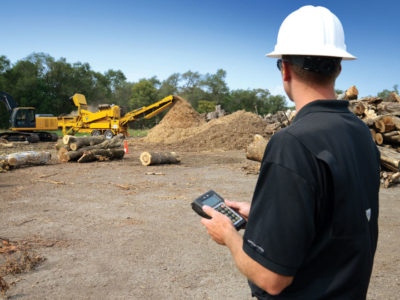If you’re a recycling operation, you know this by now: metal contaminants are not your friend. In fact, damage caused by metal contaminants that go through your recycling machines can be a costly and timely expense.
That’s why the Vermeer Damage Defense system was created for Vermeer tub grinders and horizontal grinders. Its purpose is to help owners keep their grinders productive by detecting certain metal contaminants and reducing the likelihood that it causes damage. This helps protect your investment by sensing metal vibration in the infeed. When this happens, the Damage Defense system will alert the grinder control and automatically initiate the shutdown process. It also reverses the feed system immediately, helping prevent damage to the grinder.
For those of you that own a Vermeer tub or horizontal grinder, it’s important to properly calibrate the Damage Defense system on your machine in order for it to function properly. To get started, here’s what you should do. Remember to reference your machine’s operator’s manual for more information.
How the Damage Defense system works
The calibration process is important to understand, not only for the initial setup, but for ongoing calibration as well. As material changes, the Damage Defense system will require a new calibration each time you switch to a different material for the system to work properly.
First, let’s look at how the system works. When the system is calibrated properly, green lights will flash on the control box while grinding, indicating an allowable tolerance of vibration. If a contaminant enters the mill area outside of the tolerances calibrated and makes contact with either the anvil or hammermill, the system will activate and reduce engine speed to low idle. When this happens, the system will automatically disengage the clutch, lower the thrown object deflector, reverse the infeed and sound a warning horn. The operator will then need to shut the engine off and remove the contaminant before reactivating the system and continuing to grind.
Before setting up the system
To calibrate the control box, you’ll need to verify the Damage Defense system is selected within the DP10 controller. In the main menu, select “Setup,” then “DMG Def Config” and then verify “DMG Defense” is selected. With the machine off, set the fine-tune knobs to zero, the course gain switches to L for low and the reset arm switch to reset. It’s important to note that with the switch set to reset, the Damage Defense system will not be in operation. The reset mode bypasses the Damage Defense system and will not control machine functions.
How to initially set up the Damage Defense system
To set up the Damage Defense system, start the machine and begin a normal grinding procedure. Adjust each fine-tune knob higher until green lights begin to flash. The green lights should be jumping, depending on the material density as it strikes the anvil and hammermill. The optimal peak on the green light bar is about .5-in (1.27-cm) below the beginning of the red bar. If the fine-tune knob adjusts to 10 without achieving the desired magnitude, return the knobs to zero and adjust the course-gain switch from L to M, and readjust the fine-tune knobs to find that optimal peak. Repeat this step if the fine-tune knob hits 10 again without any results.
When grinding a wide variety of material types, calibration should occur while grinding the highest density material. For example, in yard waste, there could be large chunks of solid wood. The wood should be ground during calibration to reduce the likelihood that it would activate the system while grinding the yard waste. Once you have reached the desired sensitivity on the green light bar and the fine-tune knobs are locked, the system then needs to be armed by shifting the top switch to the right. After the system is armed and working, it will appear on the DP10 display or remote control screen.
How to know there’s a metal contaminate sensed
From there, you are ready to proceed with your normal grinding operation. When the Damage Defense system activates and senses certain metal contaminates, there will be a prompt on the remote screen, a red light will illuminate for the circuit that was activated, and the grinder will go into shutdown sequence.
The operator will then need to exit the loader and properly shut down the grinder to inspect the mill area for damage and remove the contaminants. Also, make sure that you reset the arm switch. It will need to be cycled to the arm setting before you resume your normal grinding operation. For more details, please refer to your grinder’s operator’s manual.
Help prevent damage to your grinder by properly calibrating your Damage Defense system. If you have any questions about Vermeer tub or horizontal grinders or the Damage Defense system, contact your local Vermeer dealer today.
Vermeer Corporation reserves the right to make changes in engineering, design and specifications; add improvements; or discontinue manufacturing at any time without notice or obligation. Equipment shown is for illustrative purposes only and may display optional accessories or components specific to their global region. Please contact your local Vermeer dealer for more information on machine specifications.
Vermeer and the Vermeer logo are trademarks of Vermeer Manufacturing Company in the U.S. and/or other countries. © 2021 Vermeer Corporation. All Rights Reserved.
